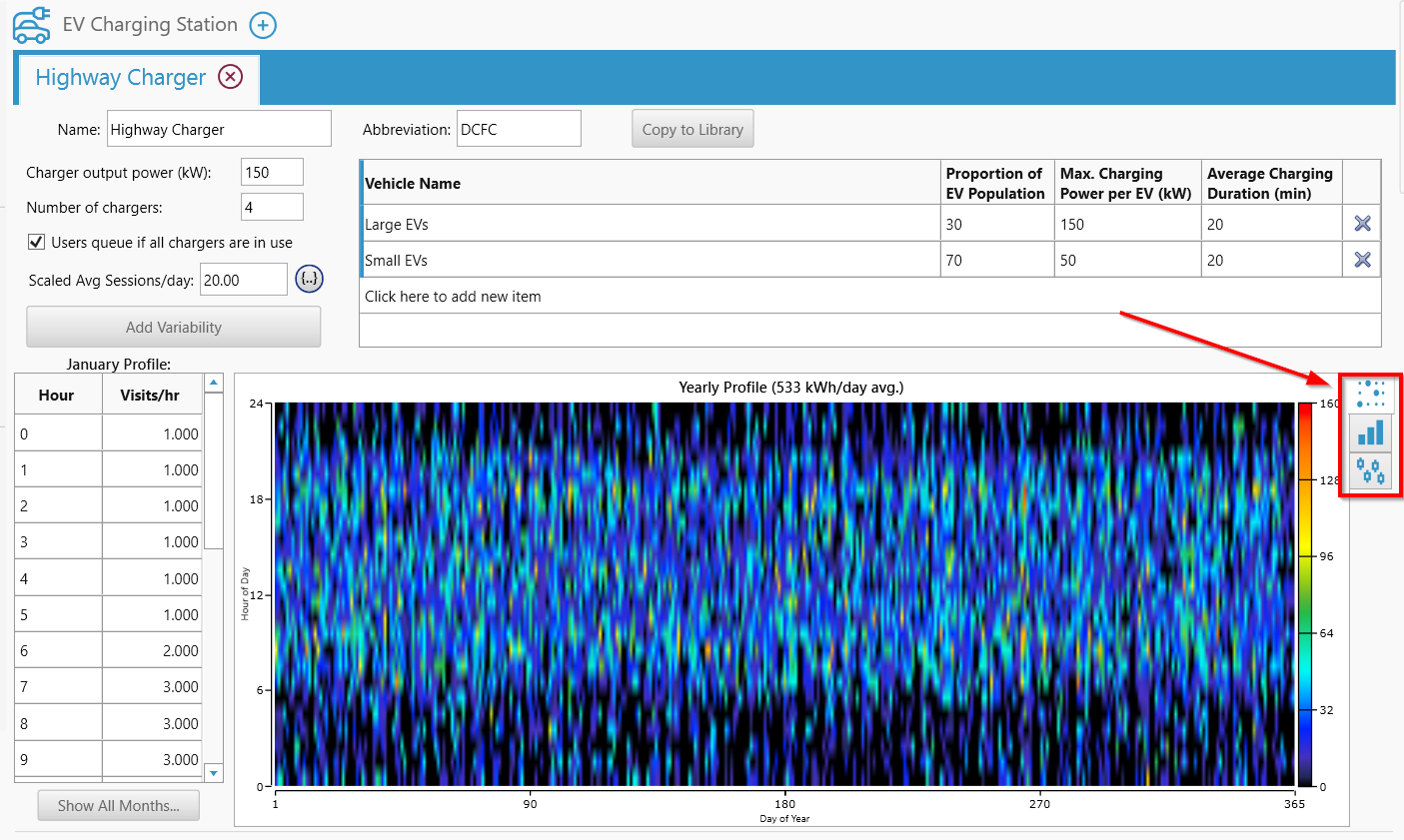
HOMER Grid 1.9

![]()
HOMER Grid can model On-Demand EV (Electric Vehicle) Charging that represents a fast charger. You can select one of the templates from the drop-down or create your own in the EV Charger Library. Click Copy to Library to save your design.
You can manage the following information on the EV Charging page.
Charging Station
Edit the inputs in the charging station section to customize the charger(s) to your specifications. The table provides a brief description of each variable in the section.
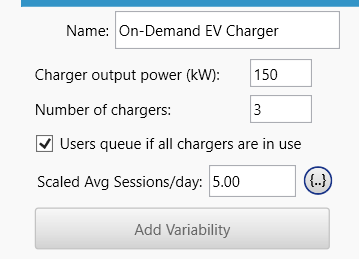
Variable |
Description |
Charger output power (kW) |
The output of power (kW) per charger |
Mean time connected (hr) |
The mean amount of time in hours the vehicle is connected to the charging station |
Number of chargers |
The number of chargers at the charging station |
Scaled Avg Session/day |
The average number of vehicle charging sessions per day |
Select Add Variability to edit the percentage of variability you would like HOMER to consider when running a simulation.
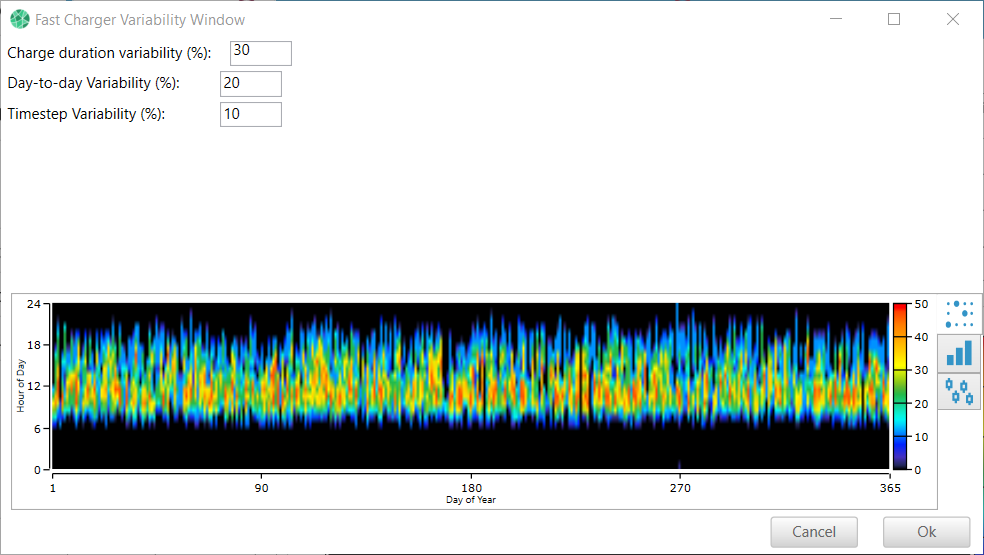
Electric Vehicles
Edit the vehicle properties to customize the Electric Vehicles you want to include in your model. Click here to add new item in order to expand your list of EVs. The table provides a brief description of each variable in the section.

Variable |
Description |
Vehicle Name |
The name or description of the electric vehicle |
Proportion of EV Population |
The proportion of the vehicle population with access to the charging station |
Max. Charging Power per EV (kW) |
The maximum amount of power required to charge the electric vehicle. |
Average Charging Duration (min) |
This average amount of time in minutes it takes to charge this electric vehicle type |
Note: For every specified session, a random electric vehicle will be drawn from the Electric Vehicle population inputs.The exact minute the car arrives will be assigned randomly within the specified hour.
Load Profile
Click on the Yearly, Daily, or Seasonal Profile tabs found on the right side of the page to change your load profile view.
Hourly Data
You can modify the daily profile, hour-by-hour in the table on the left side of the page.
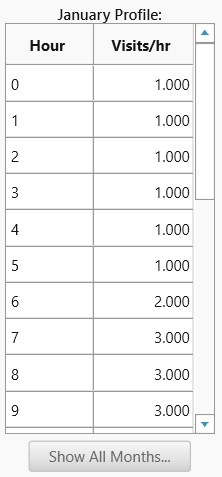
Click Show All Months... to set a different daily profile for weekends and weekdays and for each month of the year.
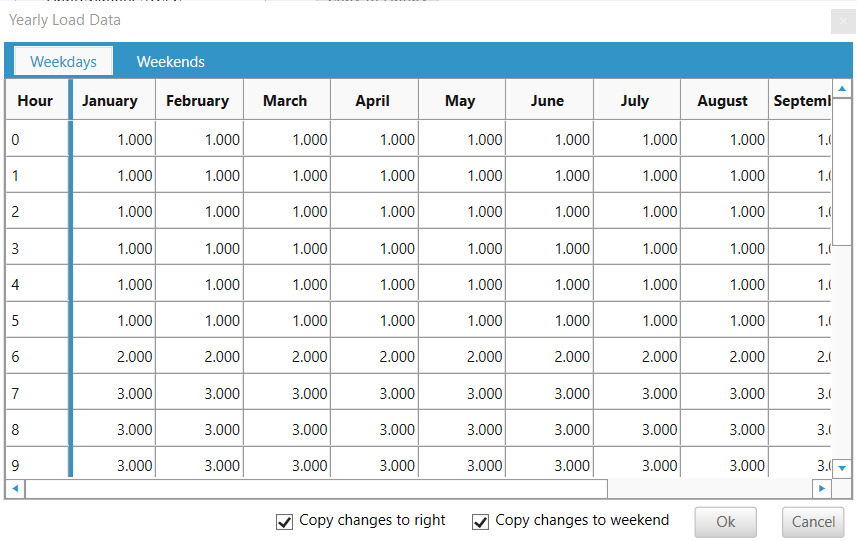
If you select Copy Changes to Right any value you enter is copied across all remaining months. For example, if you enter "10" for January, hour 0, all months, hour 0, are set to 10. If you then enter "9" for hour 0 in February, January stays set to 10 and February through December are set to 9. You can edit values for weekends or weekdays by selecting the respective tab at the top of the table. Changes made to the profile for weekends do not affect the profile for weekdays, and vice versa.
If you select "Copy Changes to Right," any value you enter is copied across all remaining months. For example, if you enter "10" for January, hour 0, all months, hour 0, are set to 10. If you then enter "9" for hour 0 in February, January stays set to 10 and February through December are set to 9. You can edit values for weekends or weekdays by selecting the respective tab at the top of the table. Changes made to the profile for weekends do not affect the profile for weekdays, and vice versa.
If you select "Copy Changes to Right," any value you enter is copied across all remaining months. For example, if you enter "10" for January, hour 0, all months, hour 0, are set to 10. If you then enter "9" for hour 0 in February, January stays set to 10 and February through December are set to 9. You can edit values for weekends or weekdays by selecting the respective tab at the top of the table. Changes made to the profile for weekends do not affect the profile for weekdays, and vice versa.
Scaled Average Sessions/Day
HOMER uses the scaled average sessions/day to specify how many electric vehicles could be connected to the charging station in a day. The Visits/hr hour profile helps determine how many vehicles can connect to the charging station during the hour.

Note: The number of chargers can influence how the vehicles are charged throughout the day. Insufficient number of chargers could lead to missed sessions. If you want 100 sessions just on weekdays, enter (100*5/7 =) 71.42 into the average sessions per day. You can see the Sessions per Year displayed in the Results, in the Electric Vehicles tab.
See also
